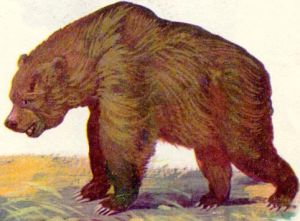 Hello! again my friend, today I'd like to share with you another animal you may have or not have seen or heard before. The animal I will be talking about today is the cave bear. This species of bear lived in Europe during the Pleistocene. Cave bears, spent more time in caves then the brown bear as the name suggests. Since these bears lived in caves, people have found entire Cave bear skeletons in caves. The bones of many Cave bears were used in WWI for phosphate.Their range spread from almost all across Europe. The Cave bear can be comparable in size to larger modern-day bears. Male Cave bears were giants compared to female Cave bears with Males weighing about a 1000 pounds and females only weighing about 500 pounds. The Cave Bears diet is uncertain as there is many evidence of them possibly being herbivores, omnivores, and carnivores. The death of Cave bears were usually in hibernation. The Cave bear went extinct 27,800 years ago due to several factors, such as from humans over hunting them.
Hello! again my friend, today I'd like to share with you another animal you may have or not have seen or heard before. The animal I will be talking about today is the cave bear. This species of bear lived in Europe during the Pleistocene. Cave bears, spent more time in caves then the brown bear as the name suggests. Since these bears lived in caves, people have found entire Cave bear skeletons in caves. The bones of many Cave bears were used in WWI for phosphate.Their range spread from almost all across Europe. The Cave bear can be comparable in size to larger modern-day bears. Male Cave bears were giants compared to female Cave bears with Males weighing about a 1000 pounds and females only weighing about 500 pounds. The Cave Bears diet is uncertain as there is many evidence of them possibly being herbivores, omnivores, and carnivores. The death of Cave bears were usually in hibernation. The Cave bear went extinct 27,800 years ago due to several factors, such as from humans over hunting them. Fun Fact
- The bones of the Cave bear were once thought to be the bones of mythical creatures such as unicorns and dragons.
Source: http://www.wikipedia.org/



